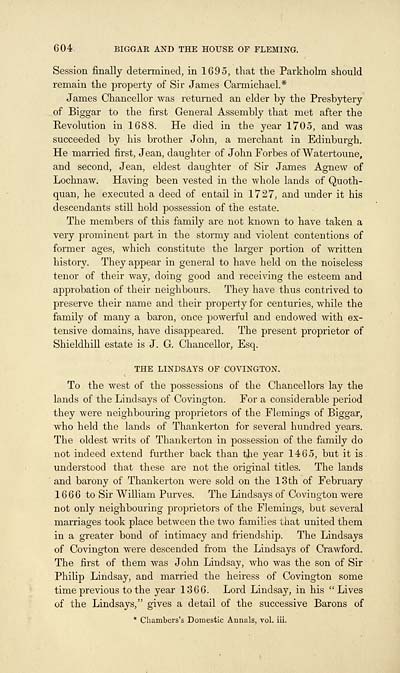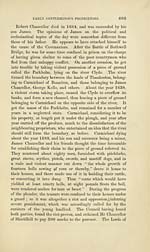Download files
Complete book:
Individual page:
Thumbnail gallery: Grid view | List view

604 BIGGAE AND THE HOUSE OF FLEMING.
Session finally determined, in 1695, that the Parkholm should
remain the property of Sir James Carmichael.*
James Chancellor was returned an elder by the Presbytery
of Biggar to the first General Assembly that met after the
Revolution in 1688. He died in the year 1705, and was
succeeded by his brother John, a merchant in Edinburgh.
He married first, Jean, daughter of John Forbes of Watertoune,
and second, Jean, eldest daughter of Sir James Agnew of
Lochnaw. Having been vested in the whole lands of Quoth-
quan, he executed a deed of entail in 1727, and under it his
descendants still hold possession of the estate.
The members of this family are not known to have taken a
very prominent part in the stormy and violent contentions of
former ages, which constitute the larger portion of written
history. They appear in general to have held on the noiseless
tenor of their way, doing good and receiving the esteem and
approbation of their neighbours. They have thus contrived to
preserve their name and their property for centuries, while the
family of many a baron, once powerful and endowed with ex-
tensive domains, have disappeared. The present proprietor of
Shieldhill estate is J. G. Chancellor, Esq.
THE LINDSAYS OF COVINGTON.
To the west of the possessions of the Chancellors lay the
lands of the Lindsays of Covington. For a considerable period
they were neighbouring proprietors of the Flemings of Biggar,
who held the lands of Thankerton for several hundred years.
The oldest writs of Thankerton in possession of the family do
not indeed extend further back than the year 1465, hut it is.
understood that these are not the original titles. The lands
and barony of Thankerton were sold on the 13th of February
1666 to Sir William Purves. The Lindsays of Covington were
not only neighbouring proprietors of the Flemings, but several
marriages took place between the two families that united them
in a greater bond of intimacy and friendship. The Lindsays
of Covington were descended from the Lindsays of Crawford.
The first of them was John Lindsay, who was the son of Sir
Philip Lindsay, and married the heiress of Covington some
time previous to the year 1366. Lord Lindsay, in his "Lives
of the Lindsays," gives a detail of the successive Barons of
* Chambers's Domestic Annals, vol. iii.
Session finally determined, in 1695, that the Parkholm should
remain the property of Sir James Carmichael.*
James Chancellor was returned an elder by the Presbytery
of Biggar to the first General Assembly that met after the
Revolution in 1688. He died in the year 1705, and was
succeeded by his brother John, a merchant in Edinburgh.
He married first, Jean, daughter of John Forbes of Watertoune,
and second, Jean, eldest daughter of Sir James Agnew of
Lochnaw. Having been vested in the whole lands of Quoth-
quan, he executed a deed of entail in 1727, and under it his
descendants still hold possession of the estate.
The members of this family are not known to have taken a
very prominent part in the stormy and violent contentions of
former ages, which constitute the larger portion of written
history. They appear in general to have held on the noiseless
tenor of their way, doing good and receiving the esteem and
approbation of their neighbours. They have thus contrived to
preserve their name and their property for centuries, while the
family of many a baron, once powerful and endowed with ex-
tensive domains, have disappeared. The present proprietor of
Shieldhill estate is J. G. Chancellor, Esq.
THE LINDSAYS OF COVINGTON.
To the west of the possessions of the Chancellors lay the
lands of the Lindsays of Covington. For a considerable period
they were neighbouring proprietors of the Flemings of Biggar,
who held the lands of Thankerton for several hundred years.
The oldest writs of Thankerton in possession of the family do
not indeed extend further back than the year 1465, hut it is.
understood that these are not the original titles. The lands
and barony of Thankerton were sold on the 13th of February
1666 to Sir William Purves. The Lindsays of Covington were
not only neighbouring proprietors of the Flemings, but several
marriages took place between the two families that united them
in a greater bond of intimacy and friendship. The Lindsays
of Covington were descended from the Lindsays of Crawford.
The first of them was John Lindsay, who was the son of Sir
Philip Lindsay, and married the heiress of Covington some
time previous to the year 1366. Lord Lindsay, in his "Lives
of the Lindsays," gives a detail of the successive Barons of
* Chambers's Domestic Annals, vol. iii.
Set display mode to:
![]() Universal Viewer |
Universal Viewer | ![]() Mirador |
Large image | Transcription
Mirador |
Large image | Transcription
Images and transcriptions on this page, including medium image downloads, may be used under the Creative Commons Attribution 4.0 International Licence unless otherwise stated. ![]()
| Histories of Scottish families > Biggar and the House of Fleming > (636) |
|---|
| Permanent URL | https://digital.nls.uk/94846914 |
|---|
| Description | A selection of almost 400 printed items relating to the history of Scottish families, mostly dating from the 19th and early 20th centuries. Includes memoirs, genealogies and clan histories, with a few produced by emigrant families. The earliest family history goes back to AD 916. |
|---|

